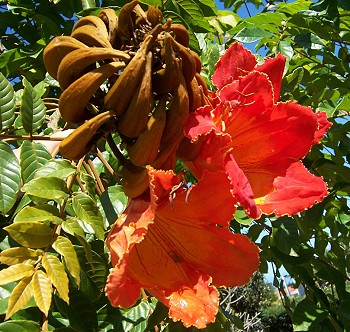
|
|
African tulip tree - Spathodea campanulata
|
African tulip tree - Spathodea campanulata
Spathodea is a monotypic genus in the flowering plant family Bignoniaceae. The single species is Spathodea campanulata, known as the Fountain Tree, "African tulip tree", Flame-of-the-forest or Nandi Flame. It is a tree that grows between 7–25 metres (23–82 ft) tall, native to tropical Africa. This tree is planted extensively as an ornamental tree throughout the tropics and is much appreciated for its very showy reddish-orange or crimson (rarely yellow
S.Lutea), campanulate flowers. It has the potential to become an invasive species, however.
The generic name comes from the Ancient Greek word spathe, in reference to the spadix-like calyx.
The wood is known to be very soft and brittle. The trunk is light gray and somewhat buttressed.When young, the leaves are bronze; deep glossy-green at
maturity. Large clusters of velvety buds are to see at the ends of the branches.
The flower buds form a ball-shaped cluster. Each brown banana-shaped flower bud is filled with water, forming a natural water pistol when squeezed.
These buds are often used by children who play with its ability to squirt the water. The sap sometimes stains yellow on fingers and clothes. The open flowers are cup-shaped and holds rain and dew, making them attractive to many species of birds.The outer buds bloom first before the inner ones. The tree blooms year round and a flower lasts about 3 days.
The many seeds (about 500) are in an 8" long legume that breaks open when it falls from the tree.
The seeds are very small with transparent winglets.The ripe pods split open into a woody, boat-shaped form. Children use them in boat races, by placing the opened pods in a fast flowing drain.
The flowers provide nectar for birds which may pollinate the tree.
In Neotropical gardens and parks, their nectar is popular with many hummingbirds. The wood of the tree is soft and is used for nesting by many hole-building birds. The seedlings germinate rapidly and the tree grows quickly. So it is among the first large trees to colonise wastelands. It favours moist habitats and will grow best in sheltered tropical areas. It is invasive in Hawaii, Fiji, Guam, Vanuatu, the Cook Islands and Samoa, and is a potential invader in several other tropical locations.
The seeds are edible. yet animals are said to die from a decoction of the core of the fruit. African hunters are said to have boiled the seeds to extract arrow poison.
The flower buds contain a sweet, watery liquid that is considered tonic. The soft, white timber used in making paper. In West Africa, their homeland, the wood is used to make drums and blacksmith's bellows. It has shallow roots and a tendency for branches to break off in a storm. Thus it considered unsuitable as a roadside tree.
The bark and leaves are used in traditional medicine in Ghana.Bark is used in wound healing and especially burn healing. The bark and leaves shows a wide spectrum of antibacterial activity including anti-malarial activity.Aqueous alcoholic decoctions of the leaves shows promise to be used for the treatment of malaria.The stem bark decoction has shown hypoglycemic activity in mice. An infusion is used as an enema for backache. A leaf infusion is used for urethal inflammation.
Source:
http://en.wikipedia.org/wiki/Spathodea_campanulata
http://www.naturia.per.sg/buloh/plants/african_tulip.htm
http://www.tropilab.com/spatodea-cam.html
